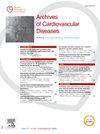Contribution of endothelial cells spatial organization in promoting cardiomyocyte maturation in a cardiac microtissue model
IF 2.3
3区 医学
Q2 CARDIAC & CARDIOVASCULAR SYSTEMS
引用次数: 0
Abstract
Introduction
The need for a better understanding of the pathophysiological mechanisms underlying cardiovascular diseases of genetic origin has led to the progressive use of cardiomyocytes derived from human induced pluripotent stem cells as a model. Despite the structural and functional immaturity of the cardiomyocytes inherent in this model, numerous studies have shown that the use of different cardiac cell types in three-dimensional co-culture allows cardiomyocytes to mature more rapidly. While the addition of other cell types is known to improve the functionality of the cardiac micro-tissue, little is known about the contribution of the spatial organisation of the cells to this improvement.
Objective
In line with the study presented at the 2024 edition of the “Printemps de la Cardiologie”, this study focuses on assessing the impact of endothelial cell spatial organization on the function of cardiac micro-tissue and the maturation of the cardiomyocytes that constitute it.
Method
A 3D co-culture model, known as a ‘spheroid’, is created using cardiomyocytes derived from induced pluripotent stem cells through the self-aggregation of various cardiac cell types. Spheroids with the same composition (70% cardiomyocytes + 15% cardiac fibroblasts + 15% endothelial cells) but different organisations (endothelial cells homogeneously distributed or concentrated at the centre of the spheroid) are compared. In addition to the assessment of contractility and calcium dynamics already carried out the previous year, an electron microscopy analysis of the ultrastructural organisation and an assessment of cell death by immunohistochemical labelling were carried out to evaluate the cellular integrity of the spheroids. Finally, RNA-Seq analysis is used for an overall analysis of gene expression in each group, which could potentially explain the origin of the differences observed.
Results
As shown last year, the amplitude of contraction and calcium kinetics differed between spheroids pre-formed with a core of endothelial cells and those with homogeneous distribution of cells. Analyses using electron microscopy, RNA-seq and immunohistochemistry show that the functional differences are also reflected at cell level, particularly in terms of cell organisation and viability.
Conclusion
The development of this model highlights the importance of the role played by cell organisation in improving the maturation of human cardiomyocytes made possible by 3D co-culture of cardiac cells.
在心脏微组织模型中内皮细胞空间组织在促进心肌细胞成熟中的作用
为了更好地理解遗传源性心血管疾病的病理生理机制,人们逐渐使用人类诱导多能干细胞衍生的心肌细胞作为模型。尽管该模型固有的心肌细胞结构和功能不成熟,但大量研究表明,在三维共培养中使用不同类型的心肌细胞可以使心肌细胞更快地成熟。虽然已知其他细胞类型的添加可以改善心脏微组织的功能,但对细胞的空间组织对这种改善的贡献知之甚少。与2024年“Printemps de la Cardiologie”上发表的研究一致,本研究重点评估内皮细胞空间组织对心脏微组织功能和构成该组织的心肌细胞成熟的影响。方法利用诱导多能干细胞衍生的心肌细胞,通过各种心肌细胞类型的自聚集,建立三维共培养模型,称为“球体”。将组成相同(70%心肌细胞+ 15%心肌成纤维细胞+ 15%内皮细胞)但组织不同(内皮细胞均匀分布或集中在球体中心)的球体进行比较。除了前一年已经进行的收缩性和钙动力学评估外,还进行了超微结构组织的电子显微镜分析和免疫组织化学标记的细胞死亡评估,以评估球体的细胞完整性。最后,使用RNA-Seq分析对每组基因表达进行全面分析,这可能解释观察到的差异的起源。结果如去年所示,以内皮细胞为核心预先形成的球体与细胞均匀分布的球体之间的收缩幅度和钙动力学存在差异。电子显微镜、rna测序和免疫组织化学分析表明,功能差异也反映在细胞水平上,特别是在细胞组织和活力方面。结论该模型的建立突出了细胞组织在促进心肌细胞成熟方面所起的重要作用,而心肌细胞的三维共培养使心肌细胞的成熟成为可能。
本文章由计算机程序翻译,如有差异,请以英文原文为准。
求助全文
约1分钟内获得全文
求助全文
来源期刊

Archives of Cardiovascular Diseases
医学-心血管系统
CiteScore
4.40
自引率
6.70%
发文量
87
审稿时长
34 days
期刊介绍:
The Journal publishes original peer-reviewed clinical and research articles, epidemiological studies, new methodological clinical approaches, review articles and editorials. Topics covered include coronary artery and valve diseases, interventional and pediatric cardiology, cardiovascular surgery, cardiomyopathy and heart failure, arrhythmias and stimulation, cardiovascular imaging, vascular medicine and hypertension, epidemiology and risk factors, and large multicenter studies. Archives of Cardiovascular Diseases also publishes abstracts of papers presented at the annual sessions of the Journées Européennes de la Société Française de Cardiologie and the guidelines edited by the French Society of Cardiology.
 求助内容:
求助内容: 应助结果提醒方式:
应助结果提醒方式:


